|
|
Southern
Africa Philately
|
|
|
|
South
Africa the Ten Rarest Stamps
A Question that may stop most Philatelists in their
tracks
is to nominate the ten rarest and/or
elusive Union stamps along with ten RSA rarities |
|
| |
I
had a dream
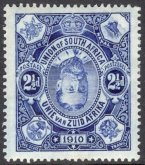
Inverted
Centre
|
|
Another
Dream
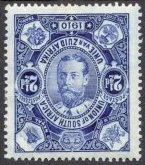 Inverted
Frame
Inverted
Frame |
|
|
|
Introduction
to South African Philatelic Rarities
By Otto Peetoom |
| |
Introduction
to a Rarities Project
The late Wilhelm Grütter (then editor) mentioned
this subject in the December 1991 edition of The
South African Philatelist and wrote...
A request was recently received
from the publishers of an intended ‘The
South African Book of lists’ to nominate
the ten most valuable South African stamps, as well
as the ten rarest moderns of South Africa...
The above reminds me of a time when
I started my research of the Union’s major varieties
and I asked an array of people to nominate the rarest
Union varieties. My question certainly stopped most
people in their tracks and in those days there was
a preconceived idea that the rarest Union variety
was the ½d Kings head with a double print (SG
3a).
For more detail on the above follow this link to another
page on this website
Grütter’s Top Ten
Having consulted a few knowledgeable philatelists
Wilhelm noted as follows:
1913 - 24 King’s Head
½d double print (SG 3a) - 2d dark plum (SACC
5c)
5/- inverted watermark (SG 15w), 1½d coil inverted
watermark (SG 20w) - 1½d booklet stamp - sideways
watermark (SG 5a)
1925 Airs 3d imperforate at left to
margin (SACC 26a)
London Printing
1d booklet stamp with sideways watermark (SG 31e)
10/- with inverted vignette (SG 39a)
Rotogravure issues
2d Tête-Bêche (SG 44e) and 1/- missing
frame (SG 62a)
Continued
in next column
|
|
Comment
on the foregoing
At the time the following items were not listed in
the Stanley Gibbons Commonwealth catalogue SG 5a,
15w, 20w and 31e. The above list is not in order of
preference, i.e. which item is regarded as No 1 and
through to No 10. Eight items are varieties; the 2d
dark plum may be regarded as controversial shade.
A Tête-Bêche is not a variety as it was
intended for booklet production and its release into
circulation unfortunate.
Also what was not taken into account
are the ‘forgotten’ varieties listed in
the early Union Handbooks such as ½d Springbok
double print and the 3d Groote Schuur with centre
or frame omitted SG 30d, 45e and 45f.
What is also relevant today are subsequent
‘unlisted’ varieties that came to light
such as ½d Springbok watermark sideways SG
30f, 4½d Merino Ram yellow omitted SG 146a
and 1/- Official SG 010b plus the ‘Stop’
variety SG 010ba.
Rarity versus Value
Rarity is determined by the number known to exist,
but that may not be reflected in its value. At auction
a major rarity may be unsold for a variety of reasons.
One of lesser value may fetch a ridiculous price because
there are two bidders on the day who are both ‘hell
bent’ on buying it.
Another factor lies in visual appeal,
for instance watermark varieties look no different
from the front than the ‘normal’.
Missing colours -
Some are more spectacular than others, should the
omitted part represent most of the design...they immediately
introduce a ‘wow factor’. Whereas a colour
that forms a minor part of the design maybe easily
overlooked. |
|
| Union
of South Africa Rarities - A Matter of Opinion |
|
|
Union
Rarities under Consideration
A practical approach to a subject that is appears more
complex that it seems, it is perhaps a good idea to
create catagories such as Postage stamps (including
booklets), Postage Dues and Officials.
Interprovincials
Stamps from the four Provinces being Cape, Natal, Orange
Free State and Transvaal continued in general use from
31 May 1910. From 19 August 1910, the stamps of the
various provinces could be used throught the Union and
continued to do so until the first definitive appeared
on 1 September 1913.
The stamps themself are of course not considered as
rarities, however certain usage might fall in the catagory
as ‘rare’. I doubt if any such item would
make it into the ‘top ten’, but they ought
to feature in the debate!
Postage Stamps
A way forward is to give consideration to each issue
and also look at the different types of errors such
as watermark and perforation varieties, double prints
plus missing colours. Stamp Booklets are also part of
this category as they are responsible for the creation
of tête-bêche pairs and
some of the rare watermark varieties originate from
the booklets.
Postage Dues
A much smaller field than the above, there are certainly
items in this field that are worth attention.
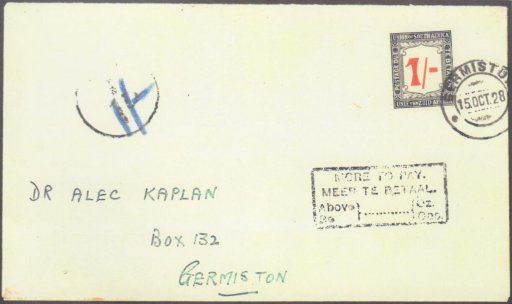 1914 1/- D7 used on cover
(the only known example)
1914 1/- D7 used on cover
(the only known example) |
Officials
Most of the rarities stem from the overprints plus certain
varieties found on the overprint.
What we
ought to consider and take into account
Whilst many of the rarest South African items are invariably
varieties other factors are also worthy of note such
as ‘normal stamps’ that may be relatively
common in mint condition but extremely elusive in used
condition...to name a few from the Union period.
Elusive
used Union Stamps
2d Union Buildings Hyphenated SG 58a, the last
1950 large format 2d Union Buildings
SG 116 and the 1948 ½d Springbok (Economy
printing) SG 126.
Among the Officials there is the 1950 2d medium
format Union Buildings SG O35, rare as a used
single and the great rarity in a pair either vertical
or horizontal. |
|
|
Contributions
from the Interested Parties |
|
From Dimitrios
Dounis...To be fair the
categories should be 3 - normal stamps. normal
officials, varieties (and let us not forget
booklets!)
Otherwise the varieties would take all the 10
top spots what with inverted centres, missing
frames or centres, inverted watermarks, wrong
or double overprints etc. In normal stamps I
would put first the 2d issue 7a (low in value
but high in scarcity) In normal officials the
1s SG O10b.
In varieties the 10s with inverted centre
|
Continued
in next column
|
|
| This
Page made its debut on Thursday 5 October
2017 and will expand during the next
few weeks. |
Union Rarities by
the late Wilhelm Grütter -
See Introduction above.
Union
Rarities by John
Shaw
Recent Communication
with Roy Ross Editor of The Springbok
Roy informed
me that he had received some notes from John
Shaw for inclusion in the November 2017 edition
of The Springbok and relates to discussion
on the subject of rarity.
John Shaw writes...The group
would often discuss matters of rarity and two
I remember especially were ‘What are the
rarest ten Union stamps and what are the rarest
ten officials?’ and it was a recent article
by Otto that reminded me of this. The discussions
would always exclude items such as missing colours,
double print and inscriptional and control pieces;
there was considerable discussion on the officials
and I do not want to dwell on these at present,
so I shall give you what I recollect as our
joint top ten rarest Union stamps which are:
KG
V 5/- inverted watermark
KG V 10/- inverted watermark
4d Recess inverted watermark
2d unhyphenated tête-bêche
2d Recess inverted watermark
Pretoria typo 6d official inverted watermark
2/6d unhyphenated official inverted watermark
6d official unhyphenated upright watermark
½d typo tête-bêche
1d typo tête-bêche |
Note
Although John said he did not wish to
dwell on the Officials, he includes
three Officials in his
‘Top Ten Rarest Union’ stamps! |
Now note that proofs, essays and the likes
of the missing centres and frames, and
the KG V ½d KG V double print are
excluded from the list, albeit some are
scarcer than some quoted above. |
|
| My
three favourite (Union) discoveries by Simon
Peetoom
1. 10s King’s
Head, watermark inverted, used.
Found it in 2000 while working at Enfield Stamp
Centre. Opened my eyes to what you could find
if you ‘keep your eyes peeled’.
2. 1s Official with ‘Official
Official’ overprint, SG O25 variety, mint.
Found in an ordinary mint collection,
not identified on the page by the collector,
indeed, I almost missed spotting it, only when
taking a second look at what I’d extracted
from the collection did I see it. When the collection
of the variety’s buyer was sold, the variety
suffered the very same fate, once again ignored
and dismissed by the auction company! |
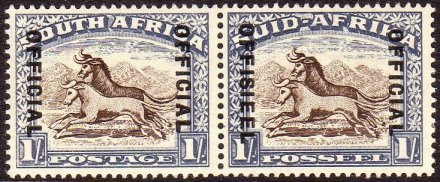 SG O25 OFFICIAL - OFFICIAL
(ex Brian Coote collection)
SG O25 OFFICIAL - OFFICIAL
(ex Brian Coote collection) |
| |
3. 1s
Official with ‘Stop’ variety, mint,
SG O10ba
Spotted the extra full stop after ‘Official’
easily enough, but upon closer inspection did
I see the wider, 21mm spacing. I couldn’t
believe my eyes! I’d found what could
well be a unique variety, a contender for the
rarest Union Official.
|
.jpg) SG O10ba Stop after OFFICIAL
(ex Brian Coote collection)
SG O10ba Stop after OFFICIAL
(ex Brian Coote collection) |
|
|
|
Comments
from other Parties
Please Note - Comments
and/or Participation is open to anyone and it is not
restricted to the members of the SACS. |
|
|
|
|
On
Wednesday 11 October 2017 I sent a
collective email to all the members of the South
African Collectors Society making them
aware of this new page on the website...it will be interesting
to see how much response is forthcoming. Prior to my
email Roy Ross, the editor of The Springbok submitted
an opinion which has been noted further down the page
under RSA.
A Question that has been asked is ‘Why
do you want to know?’...
Raising the profile of Southern African
Philately on the Internet requires the
subjects in question to become searchable via Google.
The aim is to be at the top of ‘Page one
as No1’.
For instance, this page has not been on the internet
for very long and is already on ‘Page one as No
2’, a few days ago it was No 4 and
I am confident that it will soon feature as ‘No
1’!
Other Comments
to date are
(1) Thank you
for the information and for the initiative.
Continued in next column
|
|
(2) I have
noted that you are developing a webpage on SA varieties.
It will be difficult to list ten as there are so many
that could make the list.
(3) This is a challenge. I take it
that you want answers only between 1910 and the present.
I also assume you would rule out colonial stamps used
in the Interprovincial period.
You also say stamps - which excludes
postal stationery? Most of us will have an idea of
the rarest stamp for our special interest(s). I guess
you want all the information you can get - and more.
From my perspective, I should say
that the rarest stamp is SG1 of Union used before
4 November 1910. If we are talking of groups of stamps
I imagine that almost any of those used in Mobile
post Offices would be rare. Or, there must be really
rare postage due stamps. Chris Board
(4) I don't know about rare stamps
in the way that you want but how about a column 'Difficult
stamps to find on cover (say five) Robert Johnson
(5) What a wonderful idea! Doreen
Royan |
|
|
|
| A
Review of the Union of South Africa Stamps
|
|
|
|
|
|
1910
(4 November) Opening of Union Parliament SG
1/2 |
|
This
stamp was produced in an enormous quantity and
a substantial portion of remainders was destroyed.
The stamp, whether mint or used, is common.
Although unusual for the period, a large number
of stamps are known used on the first day, on
or off cover.
An individual has ventured an opinion that SG
1 rates as a rarity used prior to its date of
issue. One may also intimate that it is rare
on cover posted to unusual destinations...even
addressed to Captain Scott in the Antarctic.
SG 1 was also valid for use in Basutoland, South
West Africa and Swaziland. Such uses are looked
upon as rare. |
| In
my opinion none of the above ‘rarity options’
would make it into the ‘Union top Ten’...this
website offers a good selection of Union
SG 1.
|
| Interprovincials
31.5.1910 - 31.8.1913
|
Rare
Interprovincial Use
|
Desirable
Dates
Desirable and/or rare dates ought to
be
31 May 1910 (Illustrated
at left)
4 November 1910 (Illustrated
below)
31 August 1913. |
Rare usage -
An item that stands out in my mind is a Natal
1d KEVII stamp from a 1907 2/6 booklet. One
stamp in the booklet is overprinted ‘NOT
FOR USE’ (SG 147a).
I have seen two covers using a pair, one stamp
with the ‘NOT FOR USE’ overprint.
One cover is dated DURBAN AU 1 07 and the other
cancelled during the Interprovincial period.
The message on the latter card indicates that
after ‘Union’ the 1d premium for
the booklet was no longer in force, thus the
Natal 2/6 booklet cost 2s 5d.
The AU 1 07 cover is illustrated in the book
The Edwardian Stamps of the South African Colonies
(2004) by Brian Trotter on page 110.
Also illustrated in colour on the back of the
dust jacket. |
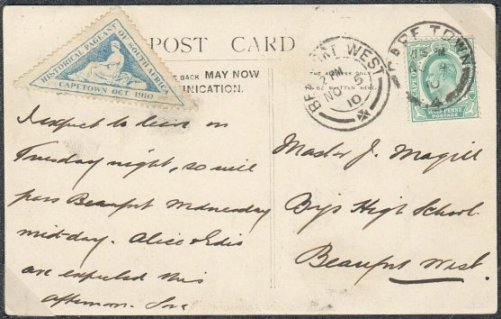 ½d
KEVII COGH used CAPE
TOWN NO 4 10
½d
KEVII COGH used CAPE
TOWN NO 4 10 |
The
Union’s first Definitive issue was not
well received by the public in as much that
pictorial essays had been submitted and approved,
only to be swept aside with an issue featuring
the head of KGV.
There are several categories that fall in the
range of being rare.
First Day of Issue
In the first instance use on the first day of
issue, 1 September 1913 is extremely rare, the
only known example with 8 out of 11 values,
excluding 1d, 2d and 1s. Ex Len
van de Kar colllection.
Sold Stephan Welz (Johannesburg) 20 September
1995 as lot 467.
First day cancels on individual stamps are also
extremely rare and very few examples are known.
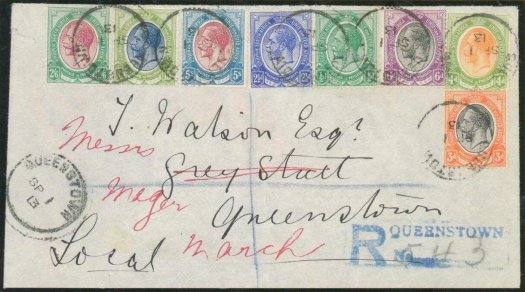 First Day Cover
QUEENSTOWN SP 1 13
First Day Cover
QUEENSTOWN SP 1 13 |
|
Rare
Shades - There are two shades
considered as rare, the ½d Mossy
Green and the 2d deep plum...neither of
the foregoing is included in the SG Commonwealth
catalogue.
The Mossy green would not be in the top
ten contest.
2d dark plum (SACC 5c) Perhaps
a controversial shade. |
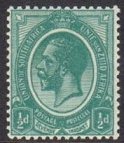 Mossy-green
Mossy-green |
|
|
Over
the years I have handled several examples
that may be deemed to be ‘dark
plum’.
Should one submit it to the PFSA expert
committee, they have a reference copy,
if it matches its ‘good’
otherwise thumbs down.
I recall visiting Montagu and having
a conversation with Michael Wigmore
about this shade and he showed me their
reference copy that decides the outcome
of any submission. |
|
Watermark
Varieties
Virtually all
values are known with an inverted watermark
except the 2/6 and £1. On the low values
the 2½d blue is the rarest inverted watermark
and on the higher values the 5/- comes out at
the top. There is a mint and used copy known.
The mint example has numerous blunt/missing
perforations which devalues its potential worth
by around 90%.
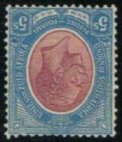 SG 15w mint
SG 15w mint |
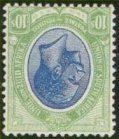 SG 16w mint
SG 16w mint
|
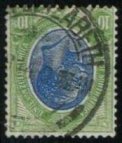 SG 16w used
SG 16w used |
Unfortunately it currently
belongs to a South African dealer who has attempted
to manipulate its value to a ridiculous level.
It is being hailed as the Union’s rarest
variety...which, in my opinion, it is not...even
if it was, its condition is against such a claim.
As I remarked in the introduction, a watermark
variety looks exactly the same from the front
as its normal counterpart.
|
Continued
in next column
|
|
| 1913
- 1924 King’s Heads Continued |
| The
10/- Inverted watermark
is certainly outside the top ten, over the years
used examples have come out of the woodwork
at a steady pace, The vast majority of 10/-
inverts have a PORT ELIZABETH cancel, but a
2008 Welz copy is cancelled OUDTSHOORN SP 12
13 (Very early use). There is at least one mint
example that suffers a short perforation.
1½d Coil stamp with Inverted Watermark
Recorded used listed in 2017 as SG
20w value £3500
1½d Sideways Watermark Ex Booklet
Listed by SG as 5c used £1800.
An example of this stamp was included in the
Len van de Kar sale at Welz (20.9.1995)
in lot 404 and the description notes...apparently
the only recorded copy...
Other King’s Head Varieties
1½d Tête-Bêche - The
first Union tête-bêche
stamps from uncut sheets produced for the 1921
3/- booklet went into general circulation.
Large quantities of 1½d tête-bêche
were issued and it is a very common.
½d Printed on the gummed side SG 3d £1500
½d Partial double print SG 3a
This variety was subject to an article
in Southern Africa Philately No 5 .
Five examples from a vertical strip of six is
recorded, stamp six is normal.
Initially the strip of six was split into three
pairs. By 1930 top pair was in the collection
of J. Ritchie and ended up with Thys Rall. The
Rall pair was sold by Stephan Welz in July 1992.
It was split into two singles and the top stamp,
regarded as the ‘best’ example with
70% doubling, has a 4mm tear.
|
The doubling
of the frame varies from 70% on the top
stamp down to 10% on the 5th stamp.
The middle pair was allegedly in an‘Overseas
collection’ (1930) but had been
split into two singles by 1921 and one
example appeared in an advertisement placed
by Tom Allan. The 3rd stamp is said to
be ex Naylor, then to Len van der Kar
and to a Cape Town collector (via Des
Hyland) who has since passed away.
The lower pair belonged
to Proffesor J.J. Smith in Stellenbosch,
he passed away in 1949, but the pair remained
in the family until September 2000.
|
|
There is another example of a
½d that is said to have
a double print, it is considered to be of a dubious
nature and suspected as a fake. The
past doyens of South African Philately pumped
its rarity and value up and at one time it was
allegedly the Union’s ‘rarest and
most valuable’ variety...which it is not...whether
it will make it into the top ten remains to
be seen.
I gain the impression that the ‘Top’
collectors of Union were promoting the items
they possessed and forgot to mention the rarer
items that they were missing...more of this
later... |
| 1926
- 27 Typographed Definitives SG 30 - 32 |
½d
Springbok, 1d Ship
and 6d Orange Tree -
First printed by Waterlow in England and then
in 1927 by the Government Printer in Pretoria.
Surprisingly the ½d and 1d both have
a fair number of listed varieties that are
worthy of note. Again sheets with tête-bêche
stamps (Intended for booklets) were on sale.
Listed as SG 30ea (½d) and SG 31da
(1d) both priced at £1500 and neither
of them are contenders for the top ten.
½d
Springbok Varieties
SG 30a Missing ‘1’ in ‘½’
priced at £2750. There is an account
of ‘how and when’ this variety
was discovered and published in issues of
the SAP.
February 1971 page 29...repeated in August
1989 page 196. At least six mint and one used.
Discovered by George Hockey who received a
letter from Wolmarandsstad with an example
used as postage circa January 1927.
Spink’s (Bloom) sale (24 October 2013)
included a block of six with the variety on
one stamp in lot 2071.
| |
SG
30a
 Missing ‘1’
in ‘½’
Missing ‘1’
in ‘½’
|
SG 30b Centre Omitted
priced at £3500
SG 30d Frame Printed double
priced at £22,000
This variety is certainly more impressive
than the ½d Kings head, more detail
may be viewed elsewhere on this website
In my opinion this could feature in the top
ten.
SG 30f Watermark Sideways
used priced at £3250
This is from a booklet and in a vertical pair
(the only known example)
For more detail follow this link to another
page on this website
This item is certainly one of the rarest Union
watermark varieties.
½d Imperforate at left to margin,
being beyond the scope of the catalogue, it
is not listed by SG and features in the SACC.
A top left corner marginal block of four in
the Spink (Bloom) sale as lot 2018.
| |
|
| SG
31b Imperfotate on 3 sides |
SG
31da - Tête-bêche |
1d Ship Varieties
SG 31a Imperforate and SG
31b Imperfotate on 3 sides... note
both the foregoing come from the same sheet.
For more detail follow this link to another
page on this website
SG 31e Watermark sideways
priced mint £2750 used £2500
|
| 1927
- 30 London Definitives SG 34 - 39 |
This
issue includes two inverted watermarks and South
Africa’s only example of an inverted centre.
The latter was found in the ‘Nissen Stock’
bought by Stanley Gibbons in October 1977.
SG 34aw 2d Watermark Inverted
priced £900 mint £950 used
SG 35cw 4d Watermark Inverted priced
£1000 mint £950 used
Spink (Bloom) Sale included mint blocks of four
of the 2d and 4d in lots 2095 and 2096.
| SG
39a
Valued at £22,000
as a single, making it
South Africa’s highest
priced variety |
|
SG 39a 10/-
Centre Inverted, two vertical pairs and a marginal
single known
For more detail follow this link to another
page on this website
Another scarce item in this issue, worthy of
note is the 10/- Aniline
Blue
For more detail
follow this link to another page on this website
|
| Comment
on the value of the 10/- Inverted centre
The theme of collecting stamps, either with
their centre or frame inverted, is popular in
America and perhaps has its origins due to the
famous ‘Inverted Jenny’. When the
two vertical pairs and single example were initially
offered in South Africa, there were no takers.
However they soon found a home with the ‘Inverted
USA Boys’. The single example was for
sale by an American dealer at ‘Pacific
97’ and Alan MacGregor and I made a joint
purchase of this item...subsequently sold to
a Cape Town collector.
One of the vertical pairs was in the ‘Invert
Collection’ of the late Mr Robert Cunliffe.
Given its sale price of $50,000 I feel certain
that it is more than likely that the buyer is
another collector of inverts rather than a Union
collector. Thus its price is not linked to the
South African collector’s purse strings,
but to ‘Big Bucks in America’.
|
|
|
| 1925
Airmail Stamps SG 26 - 29
Imperforate Varieties |
|
9d
Imperforate to left margin
- Also known used
1) On piece in a horizontal pair with normal cancelled
CAPE TOWN
2) There are three examples on piece (block of four
plus a pair) cancelled CAPE TOWN 13 JUN 25 |
|
|
| 1930
- 44 Unhyphenated Definitives SG 42 - 49
Several Illustrations are courtsey of Spink |
| |
|
|
|
|
This issue
abounds with an array of rare items and some
of the Union’s rarest varieties feature
in this issue that spanned some 15 years.
The following are worthy of note:
Tête-bêche
½d (SG 42b) Also known seperated by an
interpanneau margin.
To appreciate the layout of the sheet, see illustration
above.
1d (SG 43a) and 2d (SG 44a) The latter is considered
as one of the rarest Union items. The Spink
(Bloom) Sale included example of all the foregoing.
SG
44a
2d Tête-bêche
Ex Bloom
Lower margin reduced on illustration |
|
| Frame
or Centre Omitted - The SG policy,
when the frame is omitted, is to list
it as a ‘single’, the reason
being that the stamps are inscribed in
English and Afrikaans. Should the frame
be omitted, in theory, it may be uncertain
which language it ought to be.
|
|
|
Frame
Omitted
1d (SG 43b) - Illustration ex Bloom
(Spink sale)
SG 44c
in marginal pair with Normal ex rows
17 & 18 stamp 1 (Grosvenor Auction
May 2011 lot 2794) |
2d
(SG 44c) Watermark upright
From the known pieces it appears
that there is a partial omission on
row 13, frame omitted on rows 14, 15
& 16. On row 17, the first stamp
is total and stamps 2 to 6 are partial
making 19 single omissions possible
(18 mint and one used).
The frame omitted on R17/1
along with a normal ex R18/1. This marginal
vertical pair is on a piece cancelled
Johannesburg 21 XI 34. The rest of the
sheet was split into various units.
There is a left marginal single known,
sold by Harmers 18.12.1996 as lot 2151.
I have on record two vertical strips
of five with two normal at the top,
the middle stamp has a partial omission
and the lower two stamps with the frame
omitted.
Vertical strips from the bottom of the
sheet are also known...I have a half
arrow strip of five ex Rows 16 - 20
stamp 4. Total - almost
total plus three normal See
illustration
The late Patrick Williams had an irregular
corner marginal block of seven ex rows
16 - 20, one stamp
with frame omitted (ex R16/2) one almost
totally omitted (ex R 17/2) The remaining
five stamps are normal.
In August 2006 Patrick sent this item
to me for inspection/study, in the his
letter he wrote...I bought this
in the 1970's at a Cavendish auction
in Leeds...John Shaw knows
I have this as he was at the auction.
No one else does - except you...
2d (SG 44cwa) Watermark inverted
Reported in the August 1931 SAP stating...sold
over the counter of a small South African
P.O. It was not noticed by the P.O.
Clerk and went to a non collector who
got in touch with philatelists...
September 1931 SAP
- An Illustration of
a right lower marginal block of 18 ex
Rows 15 to 20, stamps 2 to 16 appeared... |
|
The SAP report stated
that there are 18 total omissions which is
not correct. Row 15 & 20 are normal.
On row 16 frame omitted on stamps 1, 2 &
3. Partial omission on stamps 4, 5 & 6.
Rows 17 and 18 total omission. Row 19 all
partial omissions, thus there are 15 stamps
with a total omission.
Illustrated SG 44cwa with
‘arrow’ at foot (stamp 4) ex Bloom
collection.
|
Continued
in next column
|
|
3d
Frame Omitted
SG 45f valued at £16,000 (single
stamp)
One block of eight known with five total and three
partial omissions.
This item was in the Proffesor J.J. Smith collection
and remained with his family after his death (1949)
and sold by Stephan Welz in 2000.
The SG listing is on the basis of this block.
Other partial omissions are known which originate
from different sheets. |
|
|
|
Other 1d Varieties
SG 43cwa Centre
omitted
Blurred frame Not listed
by SG as it is beyond their scope. The blurring
starts on the bottom part of the stamps on
|
| row 4 and extends
across rows 5, 6 & 7. On row 8 the blurring
stops about two thirds of the way down. I had
this variety in a top left corner marginal block
of 40 stamps (4 x 10) along with a letter dated
7 July 1933 addressed to Mr Gilbert stating that
that part of the sheet was sold over the counter
in Pretoria. See The Springbok (Jan/Mar
2012) |
One
of the Union’s Rarest Varieties
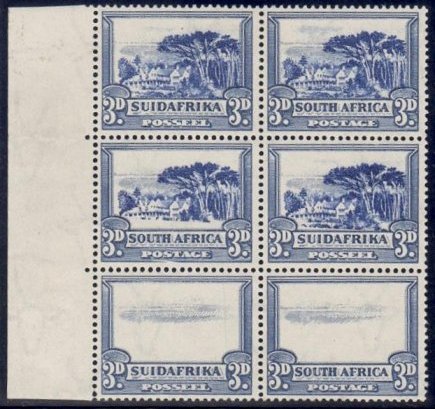 The block of six with the unique
pair was issued with an October 1997 B.P.A.
certificate number 48,134 and on the strength
of this it was listed in the 1999 Stanley Gibbons
Commonwealth Catalogue as SG 45e
The block of six with the unique
pair was issued with an October 1997 B.P.A.
certificate number 48,134 and on the strength
of this it was listed in the 1999 Stanley Gibbons
Commonwealth Catalogue as SG 45e |
|
SG 45e Centre omitted
valued at £32,000 for a pair.
A sheet from the September 1937 fourth printing,
with upright watermark, had three rows of stamps
with their centres either partly or totally
missing. Only three stamps on the left of the
sheet have a total omission, the remaining portions
on the other stamps vary in severity from left
to right.
On each row the first stamp has more of the
centre missing than the last one on the row.
Rows 4 to 10 from sheet No 8482 (figures in
blue) were split into six units and rows four
to six into blocks of six and rows seven to
ten into blocks of eight. Positive identification
of the rows is confirmed by the presence of
the marginal arrows on row ten and a constant
variety, being a break in the frame under POSTAGE,
found on R5/1.
|
| Miscellaneous
Varieties on the Unhyphenated
Definitives
Paper Joins These occur on all the
values and some are scarcer than others
|
SG
49aw 2/6 green and brown with inverted
watermark. Priced as
Mint £225 Used £275
In my opinion this item is much scarcer than its
catalogue value suggests |
|
|
|
|
|
| Republic
of South Africa Rarities - A Matter of Opinion |
|
|
Republic
(RSA) Rarities under Consideration
The Union of South Africa covers the period from 1910
to 1961 and given the conservative issuing policy compared
to later years the challenge is different to the Republic
era that started in 1961 and continues to this day.
A Republic
of South Africa used Rarity
|
1987
40c Bible stamp
Several examples are known used on FDC or on
a maxi card...but how many geniunely commercially
used examples are in circulation?
During one of my trips to South Africa, about
a year or so after it was issued,
I bought three used copies on
two pieces (cut from registered envelopes) being
a single and a pair. Used at HOLDINGS 17 XI
87. Two days prior to its ‘Official’
issue.
The SACC rates the used Bible stamp at the same
price as the mint...I think not! |
Republic
of South Africa top Rarities by Roy
Ross
Submitted
on 7 October 2017
1972 R1 missing orange, bottom of sheet
1975 15c Tourism control block of six, with
colours missing.
1987 Bible stamp FDC with 40c
1979 Xmas stamp, missing gold letters
1963 Red Cross, red cross missing
1964 Nursing stamp, missing gold
1963 Transkei Legislative Assemble, missing
green
1975 Tourism FDC orange and yellow missing (Addressed)
1990 National Stamp Day 21c Natal, missing silver
1961 12½c Protea, missing Red |
|
Continued in
next column
|
|
|
Southern
Africa Philately Issue No 4
(October 2016)
This journal includes a four page article
by Otto Peetoom covering RSA varieties up to
1990 entitled RSA - Major Commemorative
Varieties.
Updates
on the foregoing are included in subsequent
editions
No 5 (February 2017) 1992
- 93 Commemorative Varieties
No 6 (June 2017) 1979 4c Christmas
Fund Missing Gold Variety
No 8 (Due out in February 2018)
an update on the 1964 12½c Nursing,
missing Gold SG 257a.
RSA
- Major Commemorative Varieties
The listing in the above publication
includes the following items up
to 1993
There are no varieties noted from 1994 to 2004
and close to ten items are worthy of note from
2005 to 2014.
|
| No
|
Year |
Commemorative
Varieties |
Known |
| 1 |
1963 |
2½c Kirstenbosch -
Red omitted
|
? |
2 |
1963 |
12½c Red Cross omitted |
± 25 |
3 |
1963 |
2½c Transkei - Green Omitted |
12 |
4 |
1964 |
12½c Nursing - Gold omitted |
25 |
5 |
1966 |
3c Verwoerd - Brown omitted |
10 |
6 |
1974 |
4c Broadcasting - Black omitted |
10 |
7 |
1975 |
15c Tourism (se-tennant block)
- Orange & yellow omitted |
10 x 4 |
Above
known on FDC plus cylinder A & B blocks
(6) mint (2 of each) |
8 |
1975 |
9c Baines - Imperforate |
50 |
9 |
1976 |
15c Bowls Champion - Gold omitted |
20 |
10 |
1976 |
4c Erich Mayer - Imperforate |
50 |
11 |
1976 |
10c Ocean Mail - Imperforate on three sides |
5 |
12 |
|
10c Ocean Mail - Totally Imperforate |
5 |
13 |
|
10c Ocean Mail - Imperforate at top |
5 |
14 |
1978 |
15c Walvis Bay - Totally Imperforate |
25 |
15 |
1978 |
4c Dr Murray - Three sides Imperforate |
10 |
16 |
1979 |
4c Christmas Fund - Gold omitted |
5 |
| |
|
Also known on Illustrated FDC (Only one found
to date) |
1 |
17 |
1980 |
5c National Gallery - Three sides Imperforate |
5 |
18 |
1981 |
20c State Theatre - Imperforate to margin |
5 |
19 |
|
State Theatre MS Imperf - Gold & brown omitted
|
3 |
20 |
1985 |
50c Cape Parliamentary Buildings - Black omitted |
50? |
21 |
1986 |
12c Donate Blood - Black omitted |
50? |
22 |
1990 |
15c strip of 5 National Stamp Day - Silver Omitted
|
5 x 5 |
23 |
1990 |
35c Cape Funiture sheetlet - Imperforate at
right |
8 |
24 |
1992 |
35c Sport Imperforate - Several sheets known |
See note |
| |
|
35c Sport Imperforate on three sides |
Rare |
25 |
1993 |
35c SA Harbours - Imperforate at foot |
Rare |
| No
Commemorative Varieties Noted 1994 - 2004 |
26 |
2005 |
Standard Postage Prevent Blindness - Embossing
omitted |
Rare |
27 |
|
Also Imperforate or three sides imperforate |
Rare |
28 |
2009 |
75 Years SAA one sheetlet - Imperforate |
±4 |
29 |
2010 |
Digital Divide sheetlet - Imperforate |
±4 |
30 |
2010 |
FIFA SAPOA sheetlet - Imperforate |
±5 |
31 |
|
Also Imperforate & colour printing omitted
|
±5 |
32 |
2014 |
Mandela sheetlet - Imperforate |
±5 |
33 |
2014 |
Ukuthunga to sew - Embossing omitted |
1 only |
|
|
|
|
| A
Review of the Republic of South Africa Stamps
|
|
|
| March
1963 - 50th Anniversary of Kirstenbosch
| |
2½c
Red omitted SG 224a or SACC 223a, not
reported in the SAP.
Listed in 1971 SG Part I (un-priced)
1984 SG Elizabethan catalogue
priced at £750
By 2008 SG Commonwealth catalogue also
priced used at £750
|
To date I am
not able to locate anyone who has any information
on this variety, nor has anyone seen an example.
|
August
1963 - Red Cross Centenary
12½c with Red Cross omitted SG 226a or
SACC 225a
| |
A tentative report of this variety only
appeared in the August 1965 SAP and suggests
that omissions were found on a sheet bought
in Pretoria and that another sheet found
its way to England. A dealer in the UK
stated 22 copies of which one is damaged.
The debate in South Africa felt there
were more.
Most examples are single stamps, but it
does exist in a vertical pair with normal.
Lamont Smith included a top right corner
marginal example proving it came from
row 1. |
|
Used
examples - I am aware of two copies; one with
a wavy line machine cancel. Welz 12.11.1987 lot
643 - later sold by Stephan Walter and acquired
by Brian Coote.
Recently sold by Stanley Gibbons auction 1.12.2015
as lot 1103.
Partial omissions of the Red Cross also occur.
|
December
1963 - First meeting of Transkei Assembly
2½c Light green omitted SG 237a or SACC
244a
June 1964 SAP...characteristic
extends over the 5th to 9th horizontal rows...green
partly absent on the stamps of the 5th row and
completely so on those of the other four rows.
Purchased over the counter at Pretoria. The above
report is not quite correct as the stamps on row
9 retain a residue of green. Lamont Smith included
a corner marginal strip of six. Lamont
Smith strip - On R5/1
an almost total omission and the stamp ex R6/1
with missing green. S.
Welz offered a vertical pair and the stamp ex
R9/1 described as ‘virtually completely
omitted’ - Sale 30.3.1994 lot 424 and
in Sale 25.3.1992 lot 470 -
a strip of 12 from the last vertical row and
the stamp ex R9/5 is described as having the
green 99% missing. Thus partial omissions are
found on rows 5 and 9 and totalling missing
on rows 6, 7 and 8 (15 stamps).
|
|
October
1964 - 50th Anniversary of South African Nursing
12½c Gold omitted SG 257a
or SACC 249a
|
The
South African Philatelist
(April 1974) includes an illustration
of a top right marginal block of 14. It
states that the pane in question was discovered
in the UK and omissions occur on rows
2 to 6. Rows 1 and 7 being normal thus
there are 25 possible omissions and varieties
from rows 2 and 6 are likely to be in
a pair with normal.
The variety occurred on Pane ‘A’
as there are minor flaws on R1/5 being
a blue dot above left of the nurse’s
bosom plus another on her forehead.
|
|
The 1974 report notes that 17 examples
found their way to South Africa and the balance
sold overseas.
Recently
sold by Spink 26 January 2017 as lot 1918 ex Freddie
Herzberg’s collection a top right corner
marginal block of four which originates from the
piece illustrated in the SAP.
Estimated at £3000 - 4000 its hammer price
was £7000 + (29%) = £9030 |
| 1966
RSA Anniversary 7½c
A Paper Join S.
Welz on 26.10.1994 as lot 397
offered a 7½c
in a right bottom marginal strip of eight with
a paper join across three stamps.
They are unusual
during the RSA period.
|
December
1966 - Verwoerd Commemoration
3c Brown omitted SG 267a or SACC 259a. This
variety is not mentioned in the SAP and I believe
two sheets were split up. Offered in S. Welz
11.5.93 as lots 381 and 382.
Sheet 1 Total omission on stamp
11 and partial on 7 to 10 plus stamp 12.
Sheet 2
Partial omissions on stamps 1 to 5.
Lamont Smith included a top left corner marginal
block of twelve from rows 1 and 2 with partial
omissions from this sheet (S. Welz 14 June 1989)
Two pieces
from Sheet 1 at auction
(1)
Welz 30.3.1994 lot 425 in a horizontal strip
of five. The first two stamps normal followed
by a progressive partial omission across
the remaining three stamps.
(2) Harmers 3 July 1996 lot 1755
a pair with a total and partial omission.
At the time it was valued at R18,000 in
the SACC and estimated at £1,700 |
|
|
Continued in next column
|
|
July
1974 - 50th Anniversary of Broadcasting in SA
Black Omitted
4c Black inscriptions omitted
SG 345a or SACC 356a.
This error occurs in the bottom two rows of the
sheet making ten examples possible.
Note The stamp on row 8 has the
‘R’ in ‘RSA’ omitted .
Lamont Smith included a bottom marginal single.
A positional strip of
six was offered by S. Welz on 26.10.1994 as
lot 397.
In the description it mentions that a photograph
of the original multiple was taken prior to
splitting it.
The same multiple was sold in the Spink (Pierron)
sale on 8.12.2009 as lot 1680.
The October 1994 S. Welz sale included a host
of RSA varieties and also included.
1976 15c Bowls
Champion
Double Print
Lot 400 offered a with a double print of Gold
- SACC 400a.
|
|
November
1975 SA Tourism - Four 15c se-tenant designs
Orange and yellow omitted - SG
388ab or SACC 393a - 396a
This is a variety that is difficult to see
unless one compares it to a ‘normal’.
Colour on ‘RSA’ and ‘15c’
omitted.
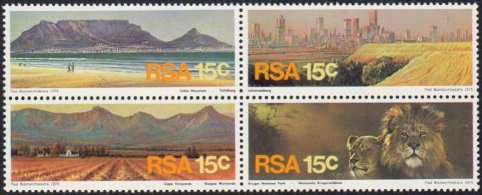 Normal se-tenant
Block
Normal se-tenant
Block |
There is a footnote in SG...At least
two sheets, one...used to prepare
official first day covers at Pretoria...
Sheet format - Cylinder
A & B with forty stamps on each pane
producing twenty se-tenant blocks of four.
Missing
Colours Cylinder Blocks - Both A
& B were offered as blocks of six in Welz
on 11.5.1993 in lots 402 and 403 with a note...only
1 other ‘A/B’ block known to exist....The
foregoing suggests that two of each cylinder
has survived and contradicts the SG footnote
which states ‘the other sheet’
was broken up for use on FDCs.
A more likely explanation
If two sets of cylinder blocks survive, it
is reasonable to assume that they originate
from two sheets and may have been accepted
as ‘normal’ until news of the
colour omissions became known.
The Philatelic Bureau in preparing First Day
covers would remove the selvedge from the
sheets, split the stamps into blocks of four
before proceeding.
Cylinder blocks at Auction
Harmers 2.09.2004 lots 1041
& 1042
Spink (Pierron) sale on 8.12.2009 as lots
1683 (cyl A) & 1684 (cyl B).
|
SA
Tourism - Missing Colour on FDC
An example was offered by Stephan Welz on 14.8.2007
as lot 761.
Another FDC featured in the Spink (Pierron) sale
on 8.12.2009 as lot 1685.
|
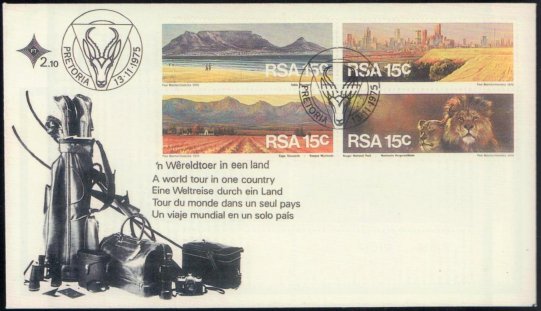 FDC - Orange and yellow
omitted -
Colour on ‘RSA’ and ‘15c’
omitted
FDC - Orange and yellow
omitted -
Colour on ‘RSA’ and ‘15c’
omitted |
June
1975 Thomas Baines Centenary - 9c Imperforate
Unlisted by SG (390 variation) - SACC 385a.
A top marginal pair was offered by Welz on 11.5.1993
as lot 401.

S. Welz 24.11.1993
- lot 473 & 30.3.1994 - lot 430
|
This variety is the first
RSA commemorative imperforate and three others
followed during 1976 and in 1978. |
April
1976 - 15c World Bowls Champions Gold overprint
omitted
Partial on stamp four and completely on stamp
5 & 6. Not listed by SG and SACC 400c.
Illustration at foot of page.
Welz 11.5.1993 as lot 404
top corner marginal strip of six and re-offered
again on 30.3.1994 as lot 431.
|
April
1976 - Erich Mayer Centenary - 4c Imperforate
SG 399a or SACC 401a.
In keeping with many of the above varieties
I have found no reference to them in the SAP.
S. Welz offered a right marginal pair in their
11.5.1993 sale as lot 406 and a top marginal
pair on 26.10.1994.
The illustrated imperforate block
of four featured on 19.3.1997 as lot 501 and
incorrectly described as being from the 1975
Thomas Baines issue. |
|
|
|
|
| October
1976 - Ocean Mail Centenary
|
10c Imperforate
SG 409a or SACC 411a
Also Imperforate on three sides or
imperforate at top.
The item on the right is probably one of the
most interesting RSA imperforates. The top two
strips were offered by Welz as lot 395 on 23.3.1988
with a tentative description.
All four rows subsequently
appeared in their 24.11.1993 sale as lot 463
stating a P.O. clerk had roughly separated
the above units.
In addition lot 464 offered another two pairs
from the top two rows. Welz on 3.7.2002 once
again offers the above rows in lot 607 and
the description informs us...originally
severed horizontally by tearing along a ruler
by P.O. clerk...
|
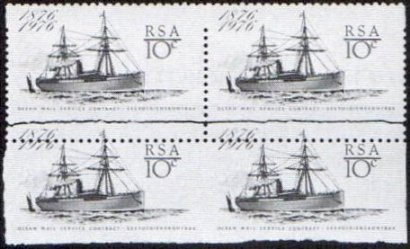 Imperforate on three
sides
Imperforate on three
sides |
|
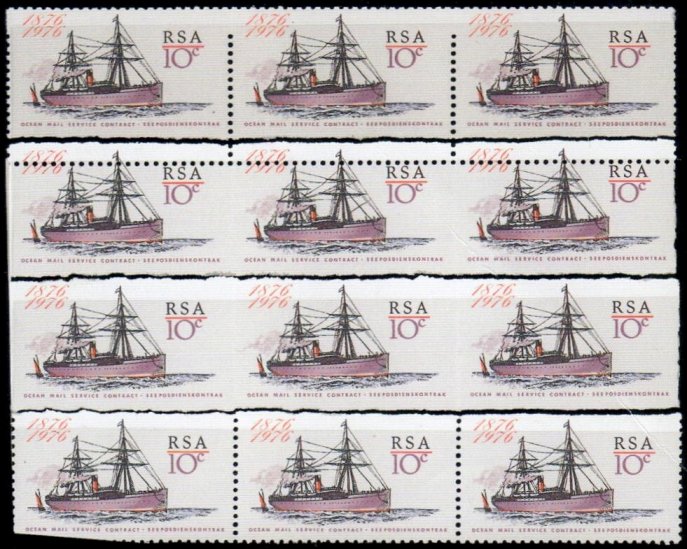 When
I initially saw the two top rows in the 1998 sale
I could not resolve what the purpose was to separate
the stamps in the way it was done. However it appears
that a diligent clerk was intent in splitting up his
stamps to the best of his ability. When
I initially saw the two top rows in the 1998 sale
I could not resolve what the purpose was to separate
the stamps in the way it was done. However it appears
that a diligent clerk was intent in splitting up his
stamps to the best of his ability. |
| March
1978 - Walvis Bay Centenary SG 439
|
15c
Imperforate - Not listed by SG and SACC
443a.
Again no information about this variety in the SAP.
Printed in sheets of 25, the cylinder strip of 5 from
the 1st vertical row is intact and offered by Welz on
24.11.1993 as lot 475.
The remaining twenty stamps make another ten pairs possible.
The foregoing sale also included a lower marginal pair
in lot 413.
Welz 11.5.1993 offered a top right corner marginal block
of four plus a pair in lots 424/425.
|
|
|
|
May
1978 - Tribute to Dr Murray
4c last stamp on each row imperforate
on three sides.
The variety is beyond the scope of the SG
catalogue and listed in the SACC as 444a.
This item has been offered in several Stephan
Welz sales either as a full sheet or in strips
of five. At least 2 sheets were found (10
strips of 5)
Sheet
1 - Offered as a
full sheet at Welz 12.11.1987 in lot 658 and
described as having a light crease on the
top right hand stamp and there is a faint
‘3’ in pencil in the top right
margin. The sheet was offered in April 2000
and again in their 21.7.2004 sale as lot 566.
Sheet
2 - Ex Lamont Smith Top marginal
strip offered twice at Welz. 12.10.1991, lot
335 and 18.4.2000 as lot 537.
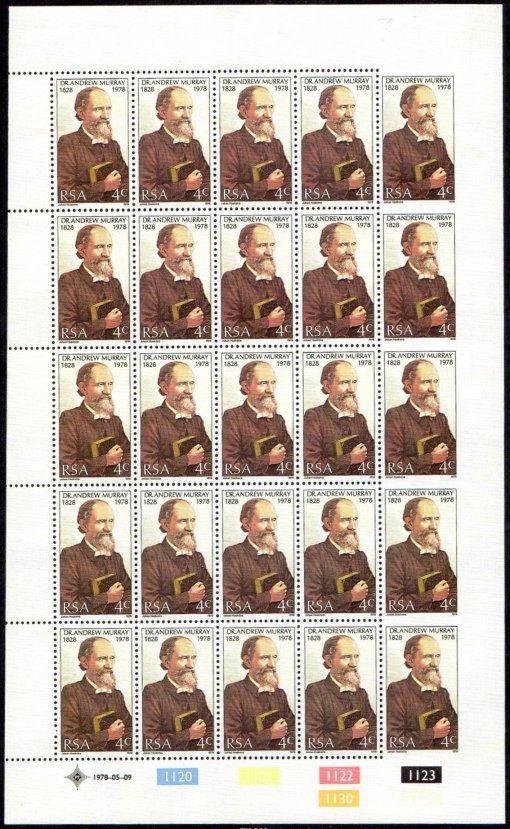 Welz 21.7.2004
- lot 566
Welz 21.7.2004
- lot 566
The above
sheet is accompanied by an 14 July 1897
original letter
written by Dr Andrew Murray at King
Williams Town. |
Two different
strips of 5 on 11.5.1993, lot 426 and 24.11.1993,
lot 474.
The lattter offered again on 30.3.1994 as
lot 435.
Bottom marginal
cylinder strip of 5, Welz 26.10.1994, lot
414.
|
Continued in next column
| Please
Note
This page is nowhere near completion, information
and illustrations will be added on a regular
basis. RSA Commemoratives will be completed
first, followed by the Definitives. |
|
|
November
1980 National Art Gallery
5c Three sides Imperforate
This variety is beyond the scope of the SG
catalogue and listed in the SACC as 485a (SG
481 variety)
First offered by Welz in Lamont Smith sale,
then on 28.3.1990 as lot 630 and again on 19.3.1997,
lot 505. Re-appeared once more 18.4.2000 in
lot 538.
I believe it is the
same strip of five and I do not know whether
it is the only known example.
May
1981 State Theatre
20c Right margin Imperforate
Another variety beyond the scope
of the SG catalogue and listed in the SACC as
494a. I have only traced this item once in a
Welz auction on 18.4.2000 as lot 539.
|
|
|
1981
State Theatre Miniature Sheet No 9 (SG
MS 492)
Imperforate with Gold & brown omitted
When Welz was still known as Sotheby’s
Johannesburg, I first encountered this item
in a 5 July 1983 sale as lot 447, described
with a horizontal crease and said to be one
of three recorded. Probably ex Lamont Smith.
I purchased an example for a client
in 1989 and was informed that most of the known
examples suffer a horizontal machine crease.
A copy described without a crease was on offer
by Welz in lot 428 on 11.5.93. Another (without
comment) on 26.10.94 in lot 415 and once more
on 18.4.2000, lot 540. During
2012, in June and November, the same example
was offered in two Welz sales and described
as being...one of only two non-creased m/sheets...
If one can believe the foregoing it does imply
that there ought to be more than three examples
as suggested in 1983.
|
|
|
|
|
|
RSA
1979 4c Christmas Fund Missing Gold Variety
- SG 464a |
|
This
variety was subject to a seperate article in
Southern Africa Philately
No 6 (June 2017) I had not seen an example before,
but fortunately the owner of a cylinder strip
of five made contact with me and provided the
circumstances of its discovery.
The ‘Missing’ Colour discovery
The owner wrote...My mother bought all the
new issues from Isando post office for us. The
company that my mother worked for was Girlock.
They bought full sheets and she then bought
the control blocks or cylinder blocks from the
company’s postal department. The rest
of that sheet was used for sending accounts
etc. to customers. At some stage afterwards
I took over my brother’s stamps, early
1980s and with the sorting I found this strip
without the gold. As we belonged to
Kempton Park Philatelic Society in those days
I showed it to them as well. In 1986 I took
it to Glen and Velda Carpendale to send to the
Philatelic Federation of Southern Africa Expert
Committee for assessment. As you can see on
their certificate (No 8568) dated 1 Nov 1986,
that it is genuine in their opinion...
Following the PFSA certificate
it was recorded and illustrated, in black
and white, in the RSA Stamp Study Group Newsletter
No 33 (December 1986).
Illustrations
Top left Cylinder strip with Gold
omitted
Lower left ‘Normal’ with cylinder
‘1225’ in Gold
|
| The
owner continues...I then sent the information
to, if I remember correctly, International Philatelic
Services in Johannesburg which arranged to be
published in the SACC catalogue. November 1996
I sent the info to Stanley Gibbons...which
decided that they will list it in their catalogue.
Stanley
Gibbons Correspondence - The owner
wrote to SG on 20 November 1996 and received
a reply on 7 January 1997 from the Catalogue
Editor David Aggersberg who wrote....I have
not previously heard of this missing colour
error...I can certainly confirm that
the missing gold error will be listed in the
next edition of the Part I (British Commonwealth)
catalogue as no 464a.
The variety is
listed for the first time in the SG 1998 Part
I Volume 2 edition. Other than the RSA study
group, as far as I am aware this variety has
not previously been chronicled or recorded in
the Philatelic press.
Possible
Valuation - This 4c commemorative was
printed in sheets of 25; in panes of four and
the first question to mind is what the fate
of the other copies was. I pointed out that
it is not an obvious error and may easily be
overlooked. If there were other sheets, it may
be possible that ‘missing gold’
examples are included in collections which are
regarded as ‘normal’.
The variety lacks
visual appeal and it is similar to the missing
colours on the RSA 1985 Cape Parliament 50c
(missing black) and 1986 Donate blood 12c black
inscription omitted. In my opinion both these
varieties, along with the missing gold lack
a ‘wow’ factor. Keen collectors’
of RSA varieties would love to include such
an item in their holding of errors.
It is normal practise
to leave the likes of this ‘missing gold’
un-priced in a catalogue as it has no trading
or auction history...thus, currently its actual
value remains somewhat academic.
Missing Gold SG 464a on FDC
I was informed recently that this variety
is also known on First Day covers. Given that
the gold lettering is difficult to see...such
a variety can easily be missed. It was sold
in a Stephan Welz sale.
|
Continued
in next column
|
|
|
A
lack of new material (1981 - 1985)
RSA Varieties took a back-seat for several years
and nothing of note appeared until 1985, an
omission of a black inscription and a similar
variation followed a year later. Both these
varieties are not very striking and I assume
that they occurred in a full sheet.
|
May
1985 Inauguration of Cape Parliamentary Buildings
50c Black omitted
SG 585a or SACC 591a
A
horizontal pair was offered by Welz on
26.10.1994 in lot 428.
I bought a copy for a client in 1989 and
that example,
ex Coote was sold by Stanley Gibbons Auctions
on 1 December 2015 as
lot 1121. |
|
|
February
1986 Donate Blood Campaign
12c Black Omitted - Inscriptions
below design, SG 594a or SACC 600a
A Fair number of these varieties appeared in Welz
starting with a single on 11.5.1993 in lot 437. |
A
lower right corner marginal block of four featured
in lot 429 on 26.10.1994,
ex Lamont Smith
A bottom marginal strip of three was offered on
8.8.2006 in lot 688.
Brian Coote’s collection included an example,
sold by SG as lot 1122 on 1.12.2015. |
|
An
RSA Rarity
I recently had a telephone conversation with
a Stamp dealer I am acquainted with and he informed
me that he was in the process of tearing up
a quantity of miniature sheets SG MS 2111 (about
60) to use as postage.
This MS is 2014 ‘Ukuthunga to
sew’ - SG MS 2111 or SACC 2264.
A footnote in SG states...‘had raised
silk screen ink applied to the inscriptions
and stamp design’...
It is similar to the embossed
dots present on the 2005 ‘Prevention
of Blindness’ stamp SG 1570 or
SACC 1753. |
| |
2014
Ukuthunga to sew
Embossing omitted
Is this the
Rarest RSA stamp? |
After having taken
the stamps from the miniature sheets, the person
concerned noticed that the embossing was absent
from one stamp.
It was the only example he had, the 2017-18
SACC includes the following footnote...a
single is known with raised printing omitted.. |
|
|
|
|
|
|
|